Themed collection Flexible energy storage and conversion

Themed issue on flexible energy storage and conversion
Guest editors Guozhen Shen, Shu-Hong Yu, Yongyao Xia, and Xiong Wen (David) Lou introduce this Journal of Materials Chemistry A themed issue on flexible energy storage and conversion.
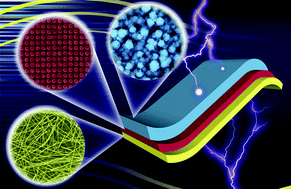
J. Mater. Chem. A, 2014,2, 10710-10711
https://doi.org/10.1039/C4TA90093F
Progress in flexible dye solar cell materials, processes and devices
The progress in the development of materials, processes, devices and industrialization of flexible dye solar cells is analyzed in this review.

J. Mater. Chem. A, 2014,2, 10788-10817
https://doi.org/10.1039/C4TA00902A
Semiconducting:insulating polymer blends for optoelectronic applications—a review of recent advances
The working principle of semiconductor:insulator blends are discussed, examining the different approaches that have recently been reported in literature.
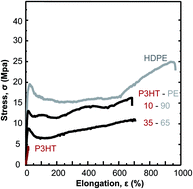
J. Mater. Chem. A, 2014,2, 10818-10824
https://doi.org/10.1039/C4TA01065E
Flexible rechargeable lithium ion batteries: advances and challenges in materials and process technologies
This review summarizes the advances and challenges in materials and process technologies in flexible rechargeable lithium ion batteries research.
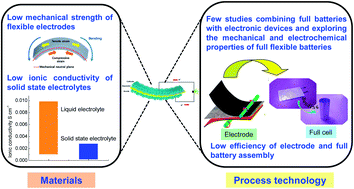
J. Mater. Chem. A, 2014,2, 10712-10738
https://doi.org/10.1039/C4TA00716F
Green energy storage chemistries based on neutral aqueous electrolytes
Recent progress of energy storage systems based on neutral aqueous electrolytes provides some quite green chemistries with promising applications in electric vehicles and smart grids.

J. Mater. Chem. A, 2014,2, 10739-10755
https://doi.org/10.1039/C4TA00565A
Flexible supercapacitors based on carbon nanomaterials
Flexible supercapacitors based on carbon nanomaterials are currently of intense interest for use in portable, light-weight, and wearable electronics.
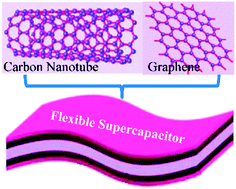
J. Mater. Chem. A, 2014,2, 10756-10775
https://doi.org/10.1039/C4TA00567H
Textile energy storage in perspective
Research on textile energy storage is making serious headway towards commercial applications to power wearable electronics.
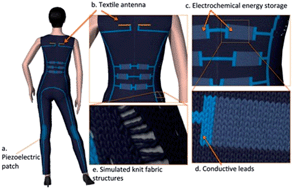
J. Mater. Chem. A, 2014,2, 10776-10787
https://doi.org/10.1039/C4TA00203B
Hydrothermal reduction of three-dimensional graphene oxide for binder-free flexible supercapacitors
Symmetric binder-free flexible supercapacitor devices with a sandwich configuration are fabricated by using ordered 3D graphene.

J. Mater. Chem. A, 2014,2, 10830-10834
https://doi.org/10.1039/C4TA01547A
Facile synthesis of titanium nitride nanowires on carbon fabric for flexible and high-rate lithium ion batteries
We demonstrate the good performance of TiN nanowires as anodes for lithium-ion batteries.

J. Mater. Chem. A, 2014,2, 10825-10829
https://doi.org/10.1039/C4TA00987H
Demonstration of highly efficient lithium–sulfur batteries
This manuscript systematically studied impacting factors in Li–S cells and proposed a new explanation of the shuttle-inhibiting mechanism of LiNO3 additive.
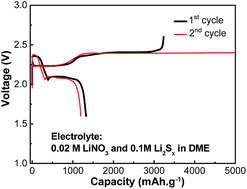
J. Mater. Chem. A, 2015,3, 4170-4179
https://doi.org/10.1039/C4TA06641C
Improved performance of p–n junction-based ZnO nanogenerators through CuSCN-passivation of ZnO nanorods
ZnO nanorods are passivated with p-type CuSCN, which improves the peak power density of the piezoelectric nanogenerators by 10 times.
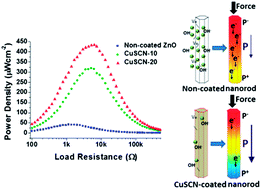
J. Mater. Chem. A, 2014,2, 10945-10951
https://doi.org/10.1039/C4TA01714E
Porosity modulation of activated ZIF-templated carbons via compaction for hydrogen and CO2 storage applications
The porosity of activated ZIF-templated carbons (AZTCs) is readily modulated by compaction to increase microporosity and packing density, which results in improved hydrogen storage of 6.5 wt% and 42.3 g l−1 at −196 °C and 20 bar.

J. Mater. Chem. A, 2014,2, 10960-10968
https://doi.org/10.1039/C4TA00530A
Nanoporous metal based flexible asymmetric pseudocapacitors
Nanoporous gold dramatically enhances specific capacitances of PPy and MnO2, resulting in ultrahigh energy density and power density of the PPy–NPG//MnO2–NPG asymmetric supercapacitor with a wide potential window.
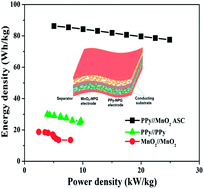
J. Mater. Chem. A, 2014,2, 10910-10916
https://doi.org/10.1039/C4TA00969J
Large area multi-stacked lithium-ion batteries for flexible and rollable applications
Large area multi-stacked lithium-ion battery modules are developed for flexible and rollable applications by employing conductive textiles.
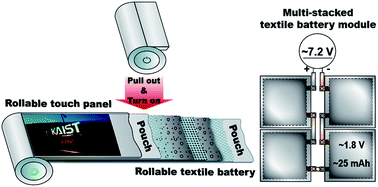
J. Mater. Chem. A, 2014,2, 10862-10868
https://doi.org/10.1039/C4TA00551A
CoNiO2/TiN–TiOxNy composites for ultrahigh electrochemical energy storage and simultaneous glucose sensing
A CoNiO2 nanowire/TiN–TiOxNy thin-film nanocomposite is directly grown on Ni foam for a high-rate charging supercapacitor and self-powered non-enzymatic glucose detection.
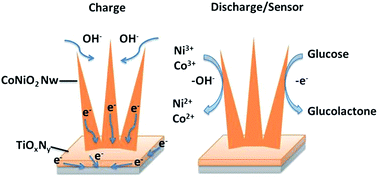
J. Mater. Chem. A, 2014,2, 10904-10909
https://doi.org/10.1039/C4TA00875H
A fast room-temperature strategy for direct reduction of graphene oxide films towards flexible transparent conductive films
Fast room-temperature reduction of GO films on PET for flexible transparent conductive films.

J. Mater. Chem. A, 2014,2, 10969-10973
https://doi.org/10.1039/C4TA00527A
Flexible, sandwich-like Ag-nanowire/PEDOT:PSS-nanopillar/MnO2 high performance supercapacitors
We demonstrate the design and fabrication of a Ag/PEDOT:PSS/MnO2 layer by layer structure for high performance flexible supercapacitors.

J. Mater. Chem. A, 2014,2, 10923-10929
https://doi.org/10.1039/C4TA01245C
Efficient synthesis of hierarchical NiO nanosheets for high-performance flexible all-solid-state supercapacitors
A simple strategy was developed to grow NiO nanosheets on carbon cloth as a binder-free electrode for a high-performance flexible all-solid-state supercapacitor device.
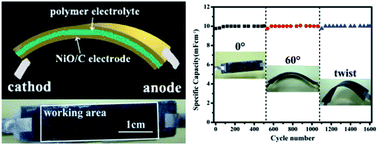
J. Mater. Chem. A, 2014,2, 10917-10922
https://doi.org/10.1039/C4TA00988F
Rational design of graphene/porous carbon aerogels for high-performance flexible all-solid-state supercapacitors
Graphene/porous carbon aerogels were rationally designed by a simple green process, exhibiting excellent electrochemical performance and long-term cycle stability as the electrode materials in flexible all-solid-state supercapacitors.
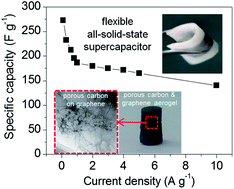
J. Mater. Chem. A, 2014,2, 10895-10903
https://doi.org/10.1039/C4TA00538D
Low-cost and flexible poly(3,4-ethylenedioxythiophene) based counter electrodes for efficient energy conversion in dye-sensitized solar cells
Electropolymerized poly(3,4-ethylenedioxythiophene) (PEDOT) on a flexible PEDOT:PSS substrate was used as a low-cost and flexible counter electrode for dye-sensitized solar cells.
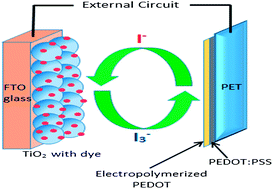
J. Mater. Chem. A, 2014,2, 10938-10944
https://doi.org/10.1039/C4TA00563E
A shape-deformable and thermally stable solid-state electrolyte based on a plastic crystal composite polymer electrolyte for flexible/safer lithium-ion batteries
A new class of shape-deformable and thermally stable solid-state electrolyte based on a plastic crystal composite polymer electrolyte for flexible/safer lithium-ion batteries is demonstrated.

J. Mater. Chem. A, 2014,2, 10854-10861
https://doi.org/10.1039/C4TA00494A
Lithium reaction mechanism and high rate capability of VS4–graphene nanocomposite as an anode material for lithium batteries
A graphene-attached VS4 composite prepared by a simple hydrothermal method is studied in terms of its lithium reaction mechanism and high rate capability.

J. Mater. Chem. A, 2014,2, 10847-10853
https://doi.org/10.1039/C4TA00371C
A flexible electrode based on a three-dimensional graphene network-supported polyimide for lithium-ion batteries
A flexible composite electrode as a cathode for lithium batteries is produced by compositing a three-dimensional graphene network and vertically aligned polyimide nanoflakes.
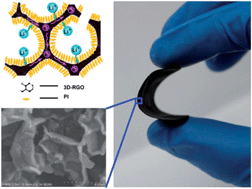
J. Mater. Chem. A, 2014,2, 10842-10846
https://doi.org/10.1039/C4TA00364K
Growth of NiFe2O4 nanoparticles on carbon cloth for high performance flexible supercapacitors
Growth of NiFe2O4 nanoparticles on carbon cloth can be realized by a facile hydrothermal process, resulting in the formation of carbon cloth/NiFe2O4 composites with promising applications in the fabrication of high performance flexible supercapacitors.
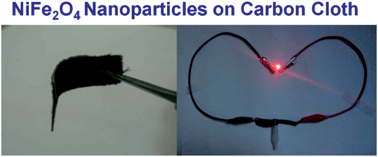
J. Mater. Chem. A, 2014,2, 10889-10894
https://doi.org/10.1039/C4TA00492B
Solution processed large area fabrication of Ag patterns as electrodes for flexible heaters, electrochromics and organic solar cells
A simple method for producing patterned Ag electrodes on transparent and flexible substrates is reported.
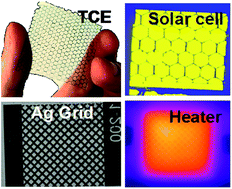
J. Mater. Chem. A, 2014,2, 10930-10937
https://doi.org/10.1039/C4TA00301B
Electrical properties and microcosmic study on compound defects in Ga-containing thermoelectric skutterudites
Microscopic analysis reveals the dual-site occupancy character of Ga in skutterudites which results in abnormal electrical properties.
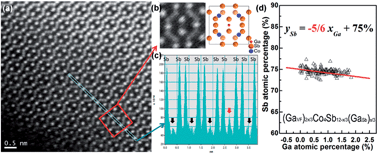
J. Mater. Chem. A, 2014,2, 10952-10959
https://doi.org/10.1039/C4TA00487F
All-solid-state flexible thin-film supercapacitors with high electrochemical performance based on a two-dimensional V2O5·H2O/graphene composite
A novel flexible supercapacitor based on two-dimensional V2O5·H2O/graphene nanocomposites was fabricated and exhibited high electrochemical performance.
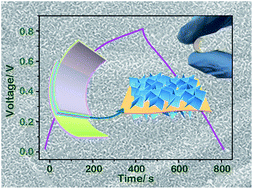
J. Mater. Chem. A, 2014,2, 10876-10881
https://doi.org/10.1039/C3TA15293F
Flexible all-carbon interlinked nanoarchitectures as cathode scaffolds for high-rate lithium–sulfur batteries
A flexible sulfur cathode electrode based on interlinked carbon nanotubes/carbon nanocages with superior conductivity and high mechanical strength was fabricated, which presented an high capacity of 1354 mAh g−1 and exhibited a high electrochemical rate capability.
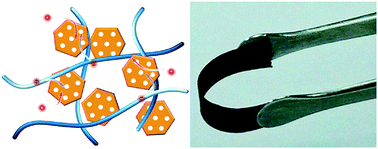
J. Mater. Chem. A, 2014,2, 10869-10875
https://doi.org/10.1039/C4TA00245H
Electrodeposition of vanadium oxide–polyaniline composite nanowire electrodes for high energy density supercapacitors
This work reports a flexible supercapacitor based on vanadium oxide–polyaniline composites (VP-1) with a large potential window and high energy density.
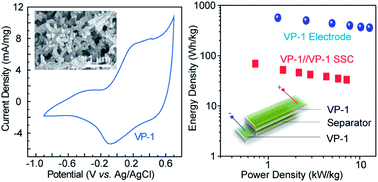
J. Mater. Chem. A, 2014,2, 10882-10888
https://doi.org/10.1039/C3TA15391F
Electrospun Fe2O3–carbon composite nanofibers as durable anode materials for lithium ion batteries
Combination of metal oxides and carbon has been a favourable practice for their applications in high-rate energy storage mesoscopic electrodes.
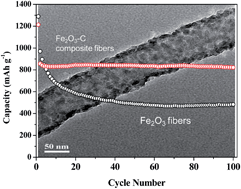
J. Mater. Chem. A, 2014,2, 10835-10841
https://doi.org/10.1039/C3TA15123A
About this collection
The aim of this themed issue is to highlight remarkable contributions made by leading scientists in this important research area and to cover the broad impacts of flexible energy storage and conversion. Due to the rapid development of flexible energy conversion and storage in recent years, we would like to take the opportunity to launch this themed issue focusing on flexible energy storage and conversion.